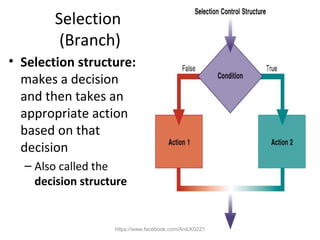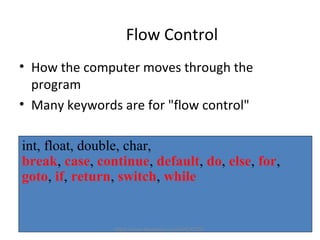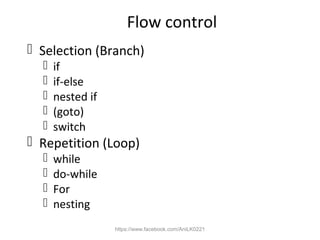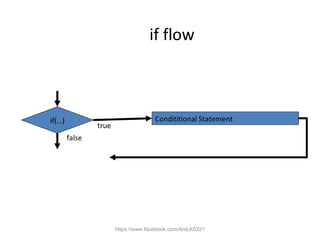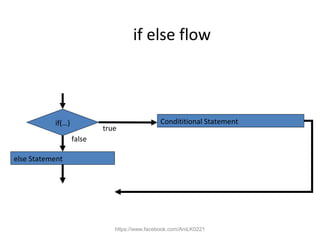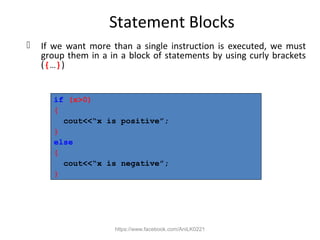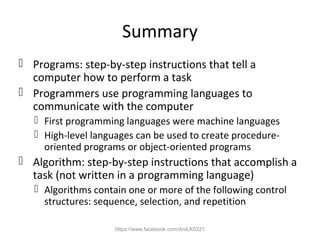Control structure C++
- 1. Control Structures ANIL KUMAR https://www.facebook.com/AniLK0221 https://www.facebook.com/AniLK0221
- 2. Control Structures • Programs are written using three basic structures – Sequence • a sequence is a series of statements that execute one after another – Repetition(loop or iteration) • repetition (looping) is used to repeat statements while certain conditions are met. – Selection(branching) • selection (branch) is used to execute different statements depending on certain conditions • Called control structures or logic structures https://www.facebook.com/AniLK0221
- 3. Sequence • The sequence structure directs the computer to process the program instructions, one after another, in the order listed in the program https://www.facebook.com/AniLK0221
- 4. Selection (Branch) • Selection structure: makes a decision and then takes an appropriate action based on that decision – Also called the decision structure https://www.facebook.com/AniLK0221
- 5. Repetition (Loop) • Repetition structure: directs computer to repeat one or more instructions until some condition is met – Also called a loop or iteration https://www.facebook.com/AniLK0221
- 6. Flow Control • How the computer moves through the program • Many keywords are for "flow control" int, float, double, char, break, case, continue, default, do, else, for, goto, if, return, switch, while https://www.facebook.com/AniLK0221
- 7. Normal flow Statement 1; Statement 2; Statement 3; Statement 4; https://www.facebook.com/AniLK0221
- 8. Flow control Selection (Branch) if if-else nested if (goto) switch Repetition (Loop) while do-while For nesting https://www.facebook.com/AniLK0221
- 9. Conditional Statements • if • if else • nested if (if – else if – else if – else) • statement blocks ({…}) • (goto) • switch (case, default, break) https://www.facebook.com/AniLK0221
- 10. if • if(condition)statement if (x==100) cout<<“x is 100”; If the condition is true, statement is executed. If the condition is false, statement is not executed. https://www.facebook.com/AniLK0221
- 12. if else if (condition)statement1 else statement2 if (x==100) cout<<“x is 100”; else cout<<“x is not 100”; If the statement1 is true, then print out on the screen x is 100 If the statement2 is true, then print out on the screen x is not 100 https://www.facebook.com/AniLK0221
- 13. if else flow Condititional Statementif(…) else Statement true false https://www.facebook.com/AniLK0221
- 14. Statement Blocks If we want more than a single instruction is executed, we must group them in a in a block of statements by using curly brackets ({…}) if (x>0) { cout<<“x is positive”; } else { cout<<“x is negative”; } https://www.facebook.com/AniLK0221
- 15. Nested if statements When if statement occurs with in another if statement, then such type of if statement is called nested if statement. if (condition1) if (condition2) statement-1; else statement-2; else statement-3; https://www.facebook.com/AniLK0221
- 16. Nested if statements In this program the statement if(a>c) is nested with in the if(a>b). if (a>b) is true only then the second if statement if(a>c) is executed. If the first if condition is false then program control shifts to the statement after corresponding else statement. if(a>=b && a>=c) cout<<“a is biggest”; elseif(b>=a && b>=c) cout<<“b is biggest”; Else cout<<“c is biggest”; https://www.facebook.com/AniLK0221
- 17. Nested if flow Condititional Statement 2else if else if Condititional Statement 3 Else Statement Condititional Statement 1if true true true false false false https://www.facebook.com/AniLK0221
- 18. goto • It allows making an absolute jump to another point in the program. • "Go to" part of a program #include<iostream.h> int main() { int n=10; loop: cout<<n<<“,”; n--; if(n>0) goto loop; cout << “FIRE!“; return 0; } https://www.facebook.com/AniLK0221
- 19. Switch Statement • Like the goto statement but more structured – Structure is good - less confusing – Its objective is to check several possible constant values for an expression and Similar to if-elseif- elseif-else but a little simpler. – So the switch statement is better than goto ! https://www.facebook.com/AniLK0221
- 20. Switch flow Condititional Statement 2case 2 case 3 Condititional Statement 3 Condititional Statement 1case 1 switch https://www.facebook.com/AniLK0221
- 21. Switch statement switch(expression) { case constant1: block of instructions 1 break; case constant2: block of instructions 2 break; default: default block of instructions } https://www.facebook.com/AniLK0221
- 22. Switch statement Switch evaluates expression and checks if it is equivalent to constant1, if it is, it executes block of instructions 1 until it finds the break keyword, then the program will jump to the end of the switch selective structure. If expression was not equivalent to constant1, it will check if expression is equivalent to constant2. if it is, it executes block of instructions 2 until it finds the break keyword. Finally if the value of expression has not matched any of the specified constants, the program will execute the instructions included in the default: section, if this one exists, since it is optional. https://www.facebook.com/AniLK0221
- 23. Switch statement switch(x) { case 1: cout<<“x is 1”; break; case 2: cout<<“x is 2”; break; default: cout<<“value of x is unknown”; } https://www.facebook.com/AniLK0221
- 24. Loops and iterations • Loops have as objective to repeat a certain number of times or while a condition is fulfilled. When a single statement or a group of statements will be executed again and again in the program then such type of processing is called loop. Loop is divided into two parts Body of loop Control of loop https://www.facebook.com/AniLK0221
- 25. Loops and iterations Control of loop is divided into two parts: Entry control loop- in this first of all condition is checked if it is true then body of the loop is executed. Otherwise we can exit from the loop when the condition becomes false. Entry control loop is also called base loop. Example- While loop and for loop Exit control loop- in this first body is executed and then condition is checked. If condition is true, then again body of loop is executed. If condition is false, then control will move out from the loop. Exit control loop is also called Derived loop. Example- Do-while https://www.facebook.com/AniLK0221
- 26. Loops and iterations • The loops in statements in C++ language are- While loop Do loop/Do-while loop For loop Nested for loop https://www.facebook.com/AniLK0221
- 27. While Loop while (expression) statement While loop is an Entry control loop And its function is simply to repeat statement while expression is true. Condititional Statementswhile(…) true false https://www.facebook.com/AniLK0221
- 28. While loop #include<iostream.h> int main() { int n; cout<<“Enter the starting number”; cin>>n; while(n>0){ cout<<n<<“,”; n--; } cout << “FIRE!“; return 0; } https://www.facebook.com/AniLK0221
- 29. For loop • For loop is an Entry control loop when action is to be repeated for a predetermined number of times. • Most used – most complicated • Normally used for counting • Four parts – Initialise expression – Test expression – Body – Increment expression for(initialization;condition;increment) https://www.facebook.com/AniLK0221
- 31. For loop int main() { int count; for (count=1; count<=10; count++) { cout <<count<<“,”; } cout<<“FIRE”; return 0; } https://www.facebook.com/AniLK0221
- 32. Do-While Loop • do statement while (expression) • Do-while is an exit control loop. Based on a condition, the control is transferred back to a particular point in the program. – Similar to the while loop except that condition in the do while is check is at end of loop not the start do { action1; } while (condition is true); action2; https://www.facebook.com/AniLK0221
- 34. Nesting of Loops • A loop can be inside another loop. C++ can have at least 256 levels of nesting. for(init;condition;increment) { for(init;condition;increment) } statement(s); } statement(s); } https://www.facebook.com/AniLK0221
- 35. Break Statement Goes straight to the end of a do, while or for loop or a switch statement block, #include<iostream.h> int main(){ int n; for(n=10;n>0;n--){ cout<<n<<“,”; if(n==5){ cout<<“count down aborted!”; break;}} return 0;} O/P: 10,9,8,7,6,5,count down aborted! https://www.facebook.com/AniLK0221
- 36. Continue Statement Goes straight back to the start of a do, while or for loop, #include<iostream.h> int main() { int n; for(n=10;n>0;n--){ if(n==5)continue; cout<<n<<“,”;} cout << “FIRE!“; return 0;} O/P: 10,9,8,7,6,4,3,2,1,FIRE! https://www.facebook.com/AniLK0221
- 37. Summary Programs: step-by-step instructions that tell a computer how to perform a task Programmers use programming languages to communicate with the computer First programming languages were machine languages High-level languages can be used to create procedure- oriented programs or object-oriented programs Algorithm: step-by-step instructions that accomplish a task (not written in a programming language) Algorithms contain one or more of the following control structures: sequence, selection, and repetition https://www.facebook.com/AniLK0221
- 38. Summary (continued) • Sequence structure: process the instructions, one after another, in the order listed • Repetition structure: repeat one or more instructions until some condition is met • Selection structure: directs the computer to make a decision, and then to select an appropriate action based on that decision https://www.facebook.com/AniLK0221



